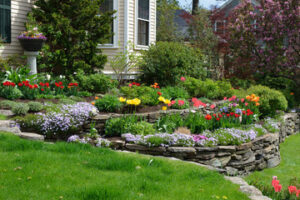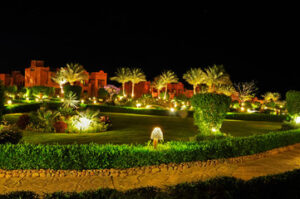A well-designed landscape enhances the beauty and functionality of any outdoor space. Strategic planning and creativity bring harmony between nature and structure. Thoughtful landscaping transforms plain areas into inviting retreats. The right balance of greenery and hardscaping creates a seamless flow.

Greensboro Landscaping involves more than just planting trees and shrubs. It combines elements like paths, water features, and lighting to create depth. Layering textures and colors adds visual interest. Each element should complement the overall theme and environment.
Creating a focal point anchors the landscape design. A central tree, water fountain, or sculpture draws the eye. Surrounding plants and structures highlight the main feature. Thoughtful positioning enhances the natural flow of the space.
Paths and walkways guide movement through the landscape. Natural stone, gravel, and pavers offer different textures and patterns. Curved paths create a relaxed feel, while straight lines provide structure. Well-designed walkways invite exploration and movement.
Lighting enhances both safety and atmosphere. Soft, ambient lighting highlights plants and architectural features. Path lights improve visibility and safety at night. Strategic lighting creates a warm and inviting ambiance.
Plants provide structure and color throughout the seasons. Evergreen shrubs offer year-round greenery, while seasonal flowers add bursts of color. Layering plants of different heights creates depth. Mixing textures and leaf shapes adds variety and interest.
Water features bring tranquility and movement to a landscape. Fountains, ponds, and waterfalls create soothing sounds. Reflective surfaces enhance light and visual depth. Proper placement of water features enhances the natural flow of the space.
Outdoor seating areas create spaces for relaxation and socializing. Built-in benches, hammocks, and shaded nooks provide comfort. Well-placed seating encourages conversation and connection. Comfortable outdoor furniture enhances the overall experience.
Hardscaping elements define the structure of the landscape. Stone walls, patios, and pergolas add architectural interest. Contrast between natural materials and greenery creates balance. Hardscaping anchors the design and enhances durability.
Terracing allows for creative use of sloped landscapes. Layered levels create visual interest and functional zones. Stone or wood retaining walls provide stability. Terraced gardens maximize planting space and improve drainage.
Native plants adapt well to local climates and require less maintenance. Drought-tolerant species reduce the need for watering. Native plants attract beneficial wildlife like birds and pollinators. Thoughtful plant selection creates a balanced ecosystem.
Borders and edges define planting areas and pathways. Stone, brick, or natural materials create clean lines. Defined borders enhance the structure of the landscape. Well-maintained edges improve the overall appearance.
Climbing plants add vertical interest and softness to structures. Vines and creepers cover walls and pergolas with lush greenery. Flowering varieties provide seasonal color and fragrance. Vertical plants create a sense of privacy and enclosure.
Mulching improves soil health and reduces weed growth. Organic mulches enrich the soil and retain moisture. Decorative mulch adds color and texture to planting areas. Proper mulching supports healthy plant growth and low maintenance.
Seasonal planting ensures year-round interest and color. Early bloomers provide color in spring, while summer plants offer lush growth. Autumn foliage and winter berries maintain visual appeal. Layered seasonal planting creates a dynamic landscape.
Privacy screening enhances the sense of seclusion. Tall shrubs, hedges, and fences create boundaries. Layered planting softens hard edges and improves airflow. Thoughtful placement of screens balances privacy with openness.
Container gardening adds flexibility and variety to landscapes. Pots and planters allow for seasonal changes and easy rearrangement. Decorative containers add color and texture to patios and decks. Grouped containers create visual impact and balance.
Low-maintenance landscaping reduces upkeep without sacrificing beauty. Perennials, ground covers, and drought-tolerant plants thrive with minimal care. Automated irrigation systems simplify watering. Thoughtful plant selection reduces the need for pruning and fertilizing.
Wildlife-friendly landscaping supports biodiversity. Bird feeders, bee hotels, and butterfly plants attract beneficial species. Providing food, water, and shelter creates a balanced ecosystem. Encouraging wildlife enhances the natural harmony of the landscape.
Open lawns create a sense of space and freedom. Well-maintained grass areas offer space for relaxation and play. Natural contours and edging define the lawn area. Balanced use of lawn and planting areas enhances visual appeal.
Outdoor structures expand the functionality of the landscape. Gazebos, pergolas, and trellises provide shade and structure. Covered areas offer protection from the elements. Thoughtful placement creates inviting spaces for relaxation.
Zen-inspired designs focus on simplicity and natural balance. Rock gardens, raked sand, and minimalist planting create a calming atmosphere. Natural elements like stone and wood add texture and depth. Open spaces and clean lines create a sense of peace.
Edible gardens combine beauty with practicality. Herbs, vegetables, and fruit trees provide fresh produce. Raised beds and containers improve accessibility and soil quality. Edible plants add texture and seasonal interest to the landscape.
Rain gardens improve drainage and reduce runoff. Strategically placed plants absorb excess water and filter pollutants. Native plants thrive in rain gardens and support local wildlife. Well-designed rain gardens enhance both function and beauty.
Reflective surfaces create the illusion of space and light. Mirrors, glass, and water features bounce light throughout the landscape. Proper placement enhances depth and dimension. Reflective elements add brightness and elegance.
Windbreaks protect plants and create microclimates. Dense shrubs, hedges, and trees reduce wind exposure. Layered planting softens wind resistance and improves comfort. Strategic windbreaks enhance plant health and overall comfort.
Rock gardens add texture and low-maintenance interest. Drought-tolerant plants thrive among stones and gravel. Varied rock sizes create natural patterns and flow. Rock gardens complement both modern and rustic designs.
Ground cover plants reduce soil erosion and improve appearance. Creeping varieties fill gaps between stones and borders. Low-growing plants provide color and texture without overpowering other elements. Ground covers soften hard edges and reduce maintenance.
Color schemes define the mood of the landscape. Warm tones create energy, while cool tones provide calm. Monochromatic designs create unity, while contrasting colors add drama. Balanced color choices create a harmonious feel.
Smart irrigation systems optimize water use and plant health. Drip systems deliver water directly to the roots. Timed and sensor-based systems adjust to weather conditions. Efficient watering supports healthy growth and reduces waste.
Garden art adds personality and creative flair. Sculptures, mosaics, and decorative elements create focal points. Natural materials and handcrafted pieces complement the landscape. Thoughtful art placement enhances the overall theme.
Native stone and wood materials blend seamlessly with natural surroundings. Rough textures contrast with soft plant forms. Local materials reduce environmental impact and support sustainable practices. Organic patterns create a timeless feel.
Shade-loving plants thrive beneath trees and structures. Ferns, hostas, and ground covers create lush understory layers. Varied leaf shapes and colors add texture. Thoughtful shade planting enhances overall balance and structure.
Living walls bring vertical gardens into tight spaces. Modular panels support a variety of plant species. Living walls improve air quality and reduce noise. Vertical greenery adds depth and natural beauty.
Layered plant heights create a natural progression. Taller trees form the backdrop, mid-sized shrubs add body, and ground covers fill gaps. Varied textures and leaf patterns enhance depth. Layered planting creates a balanced and dynamic landscape.
Ponds and wetland areas support aquatic life and biodiversity. Floating plants, reeds, and aquatic grasses create natural habitats. Balanced ecosystems reduce maintenance and improve water quality. Thoughtful pond placement enhances landscape harmony.
Colorful foliage provides year-round visual interest. Variegated leaves, deep greens, and seasonal tints create variety. Mixing leaf shapes and sizes adds texture. Foliage diversity enhances the natural balance of the landscape.
Thoughtful landscaping transforms outdoor spaces into natural retreats. Strategic use of plants, materials, and design elements creates harmony and flow. Combining modern features with organic textures enhances both aesthetics and function. A well-designed landscape provides a peaceful and inviting atmosphere for years to come.
